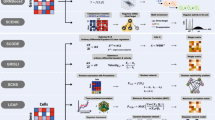Summary
The differential expression of genes in HepG2 cells caused by UC001kfo RNAi was investigated using RNA-seq. HepG2 cells were infected by Lenti-shUC001kfo lentivirus particles. The expression of UC001kfo mRNA in the HepG2-shUC001kfo cell line was detected by real-time PCR. RNA-seq technology was used to identify the difference in the expression of genes regulated by lncRNA UC001kfo in the HepG2 cell line. Gene ontology and signaling pathway analysis were performed to reveal the biological functions of the genes encoding of significantly different mRNAs. The results showed that mRNAs were differentially expressed between the HepG2-shUC001kfo cell line and the HepG2 cell line. The UC001kfo mRNA was significantly down-regulated in the stable cell line HepG2-shUC001kfo (P<0.001). Additionally, we found 19 signaling pathways or functional classifications encompassing 30 genes that played a role in cancer characteristics, cell adhesion, invasion and migration. The results also showed that the expression of many genes associated with cancer cell invasion and metastasis was decreased with the down-regulation of the lncRNA UC001kfo. LncRNA UC001kfo may play a role in regulating cancer cell invasion and metastasis. It was suggested that mRNAs were differentially expressed in the HepG2 cell line after the down-regulation of lncRNA-UC001kfo. Some took part in the extracellular matrix, cell adhesion, motility, growth, and localization. The genes encoding of differentially expressed mRNAs may participate in cell invasion and metastasis.
Similar content being viewed by others
References
Cheetham SW, Gruhl F, Mattick JS, et al. Long noncoding RNAs and the genetics of cancer. Br J Cancer, 2013,108(2):2419–2425
Xing YH, Bai Z, Liu CX, et al. Research progress of long noncoding RNA in China. IUBMB Life, 2016,68(11):887–893
Zhou CC, Yang F, Yuan SX, et al. Systemic genome screening identifies the outcome associated focal loss of long non-coding RNA PRAL in hepatocellular carcinoma. Hepatology, 2016,63(3):850–863
Yang F, Huo XS, Yuan SX, et al. Repression of the long noncoding RNA-LET by histone deacetylase 3 contributes to hypoxia-mediated metastasis. Mol Cell, 2013,50(4):303–304
Wang YY, He L, Du Y, et al. The long noncoding RNA IncTCF7 promotes self-renewal of human liver cancer stem cells through activation of Wnt signaling. Cell Stem Cell, 2015,16(4):413–425
Langmead B, Trapnell C, Pop M, et al. Ultrafast and memory-efficient alignment of short DNA sequences to the human genome. Genome Biology, 2009,10(3):25–34
Kim D, Langmead B, Salzberq SL. HISAT: a fast spliced aligner with low memory requirements. Nat Methods, 2015,12(4):357–360
Li B, Dewey CN. RSEM: accurate transcript quantification from RNA-Seq data with or without a reference genome. BMC bioinformatics, 2011,12(1):323
Audic S, Claverie JM. The significance of digital gene expression profiles. Genome Res, 1997,7(8):986–995
Abdi H. Bonferroni and Sidak corrections for multiple comparisons. In: Salkind NJ, editor. Encyclopedia of Measurements and Statistics. Thousand Oaks, California: Sage.2007.
Benjamini Y, Yekutieli D. The control of the false discovery rate in multiple testing under dependency. Annals Statistics, 2001,29(4):1165–1188
Kanehisa M, Araki M, Goto S, et al. KEGG for linking genomes to life and the environment. Nucleic Acids Res, 2008,36:D480–484
Eisen MB, Spellman PT, Brown PO, et al. Cluster analysis and display of genome-wide expression patterns. Proc Natl Acad Sci USA, 1998,95(25):14863–14868
de Hoon MJL, Imoto S, Nolan J, et al. Open source clustering software. Bioinformatics, 2004,20(9):1453–1454
Saldanha AJ. Java Treeview—extensible visualization of microarray data. Bioinformatics, 2004,20(17):3246–3248
Ye J, Fang L, Zheng HK, et al. WEGO: a web tool for plotting GO annotations. Nucleic Acids Res, 2006,34(Web Server issue):W293–297
Pan YF, Qin T, Feng L, et al. Expression profile of altered long non-coding RNAs in patients with HBV-associated hepatocellular carcinoma. J Huazhong Univ Sci Technolog Med Sci, 2013,33(1):96–101
Pan YF, Feng L, Wei LY, et al. Expression profile of altered long non-coding rnas in patients with hepatocellular carcinoma. Chin J Exp Surg (Chinese), 2011,28(3):406–407
Pan YF, Ping XG, Wei LY, et al. Research on UC001kfo participating in the invasion of hepatocellular carcinoma cells by regulating a-smooth muscle actin. Chin J Exp Surg (Chinese), 2013,30(2):274–276
Wharton KA, Zimmermann G, Rousset R, et al. Vertebrate proteins related to Drosophila Naked Cuticle bind Dishevelled and antagonize Wnt signaling. Dev Biol, 2001,234(1):93–106
Katoh M. Molecular cloning, gene structure, and expression analyses of NKD1 and NKD2. Int J Oncol, 2001,19(5):963–969
Pradhan, M, Baumgarten SC, Bembinster LA. et al. CBP mediates NF-kB-dependent histone acetylation and estrogen receptor recruitment to an estrogen response element in the BIRC3 promoter. Mol Cell Biol, 2012,32(2):569–575
Wong AW, Paulson QX, Hong J, et al. Alcohol promotes breast cancer cell invasion by regulating the Nm23-ITGA5 pathway. J Exp Clin Cancer Res, 2011,30:75
Zhao P, Zheng MG, Cheng G. et al. Enhancement of LOX and HIF-1a expressions in non-small cell lung cancer. Basic & Clinical Medicine (Chinese), 2015,35(6):776–780
Zhang GL, Wang MM, Xiong YN, et al. Mechanism of TGFB1 inhibits proliferation of A549 cells. J North China Coal Med Univ (Chinese), 2012,14(4):453–455
Acknowledgments
The authors would like to thank postgraduate Lele Ma at State Key Laboratory of Biotherapy of Sichuan University for their valuable help and revisions of the manuscript.
Author information
Authors and Affiliations
Corresponding author
Additional information
This project was supported by National Natural Science Foudation of China (No. U1404309).
Rights and permissions
About this article
Cite this article
Pan, Yf., Su, T., Chen, Ld. et al. Differential expression of genes in HepG2 cells caused by UC001kfo RNAi as shown by RNA-seq. J. Huazhong Univ. Sci. Technol. [Med. Sci.] 37, 510–515 (2017). https://doi.org/10.1007/s11596-017-1765-1
Received:
Revised:
Published:
Issue Date:
DOI: https://doi.org/10.1007/s11596-017-1765-1




